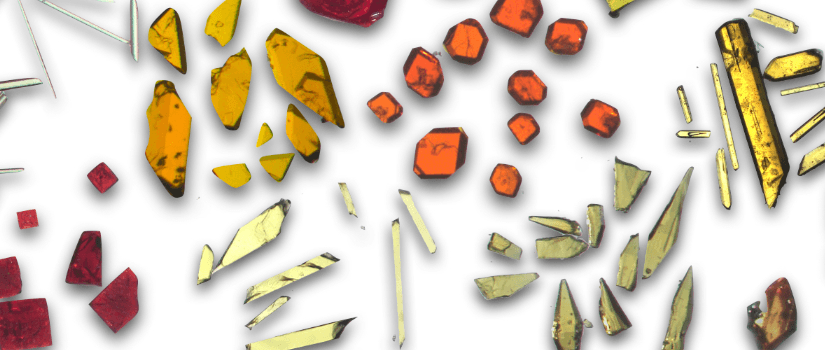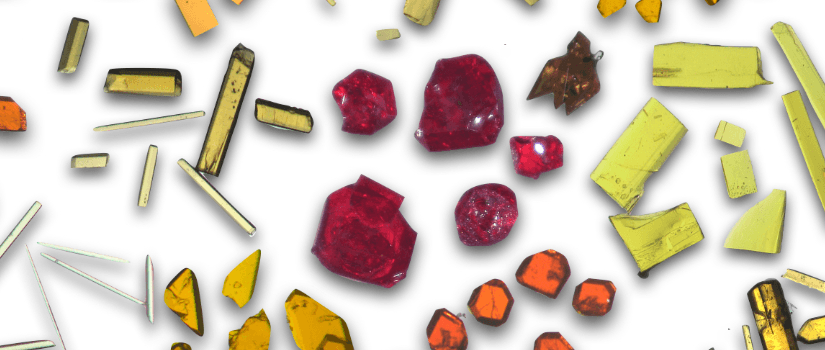By Bryan Gentry | July 15, 2020
The vibrant crystals spread across a white backdrop look like jewelry, or even candy gems. But each one represents a novel concept for safely storing highly radioactive elements from the Cold War-era construction of nuclear weapons.
University of South Carolina chemists and engineers designed these crystals to contain components of nuclear waste until its radioactive elements decay.
“Waste forms are structures in which the radioactive elements are contained, and from which they cannot escape," says Hans-Conrad zur Loye, director of the Center for Hierarchical Waste Form Materials in the UofSC College of Arts and Sciences. “You don't want the elements going into the environment, and you need this to not happen for the next 100,000 years or more, which is tricky — to say the least.”
The Center for Hierarchical Waste Form Materials recently received an $11.2 million grant from the Department of Energy to continue its research for the next four years. Over their first four years, the center’s collaborators developed prototype waste forms, including those that can contain plutonium. In this new phase of the project, they will test the longevity and resilience of the new plutonium forms as well as develop new structures to contain neptunium, americium, and the particularly problematic radioactive elements technetium, cesium and iodine.
“The waste we are working to help sequester is legacy waste — radioactive waste generated in the making of nuclear weapons,” zur Loye explains. He says the U.S. has well over 100 million gallons of highly radioactive waste from the weapons program. The waste is being stored and processed at locations such as the Savannah River Site in South Carolina. The materials will not decay entirely for many millennia and, therefore, locking the radioactive elements inside the crystal waste forms assures that they will not escape from their underground permanent storage facilities into the environment.

But each waste form has its own lifespan. The radiation emitted by the waste will eventually break down the physical structure of the crystals. While effective, the glass waste forms currently in use are able to hold only a small amount of the waste material per pound of glass, which increases the time required and the space needed to process and store the nuclear waste. The crystals zur Loye and his collaborators are developing could contain as much as 50 percent radioactive material and still hold together over the many thousands of years until after the radioactivity has decayed away.
“The Department of Energy understands how large problems such as developing concepts for stable, high-capacity nuclear waste forms is not a problem that can be successfully tackled by one or two university research groups," says Theodore Besmann, deputy director for CHWM and the SmartState Chair in mechanical engineering. “It takes a variety of types of expertise that can synergistically generate the ideas, come up with the processes for making materials previously never seen, mathematically model the materials to predict their behavior, examine and understand the crystal structures, and finally study how these candidate materials will behave over centuries of being bombarded by the radiation from its constituents. In the CHWM we have gathered some of the world’s best minds and laboratories for doing this work into a team that works across our specialties to produce holistic pictures of possible future waste forms.”
You don't want the elements going into the environment, and you need this to not happen for the next 100,000 years or more, which is tricky — to say the least.
― Hans-Conrad zur Loye, director, Center for Hierarchical Waste Form Materials
“Our international, interdisciplinary team is excited and energized to build upon the substantial accomplishments achieved during the first four years and to direct the knowledge gained to the design of new waste forms with superior stability and performance,” says zur Loye, who is the David W. Robinson Palmetto Professor and Carolina Distinguished Professor in the Department of Chemistry and Biochemistry. “We are combining experiment, characterization and modeling to generate and validate chemistry and structure motifs that can lead to materials that effectively immobilize nuclear waste. This extensive integration of simulation and data-enabled discovery will lead to revolutionary forms of matter with tailored properties from which the next generation waste forms will emerge.”
The Center for Hierarchical Waste Form Materials was created in 2016 when the Department of Energy awarded an 8 million dollar grant. It was one of four Energy Frontier Research Centers created at that time. This year, it was one of only two EFRCs to receive a full extension. The Center includes collaborators in the University of South Carolina College of Arts and Sciences and the College of Engineering and Computing. Other research partners include scientists at Clemson University, the University of Florida, Alfred University, the University of Michigan, Savannah River National Laboratory, Pacific Northwest National Laboratory, and the French Alternative Energies and Atomic Energy Commission (CEA).
